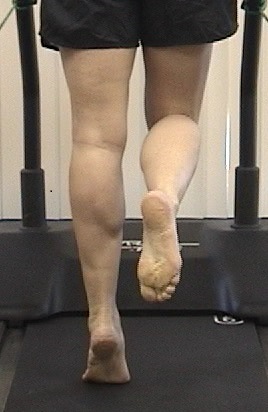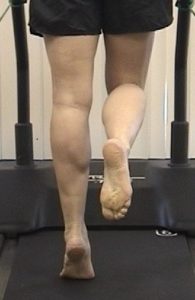Aging Muscles & Tendons: Achilles/Calf Strain

As we age muscles and tendons will change. Calf muscles in older individuals are weaker, smaller, shorter, less stiff, and not as coordinated.
Older athletes may experience greater incidence of injuries (Tauton 2003, McKean 2006). Two most common repetitive use injuries in older runners are Achilles tendonopathy and strained calf muscle (Marti 1988).
A greater number of birthdays lead to physiological changes occurring in muscles and tendons. Studies have shown compared to younger individuals the calf muscles in older males are:
- 20% to 25% weaker (Karamandis 2006)
- Smaller in size – volume or thickness (Nanci 2003)
- Shorter in length (Nanci 2003)
- More compliant or less stiff (Karamandis 2006)
- Less coordinated in terms of the stretch shortening activity of the muscle (Hoffren 2007)
It may sound contradictory that muscles and tendons that are shorter are less stiff, but it is possible. Typically we equate short muscles with stiff muscles. This is not always true. Using the analogy of a metal spring it is possible to have two springs that are the same length, same number of coils, same space between each coil, and one spring can be stiffer than the other. The spring made of a thicker metal will be stiffer than a spring that is thinner. A smaller thinner calf muscles is likely to be less stiff compared thicker calf muscle.

Springs are the same length one is thicker & stiffer than the other
Perhaps the larger size and greater stiffness of the Achilles tendon and calf muscles that is present in younger males may be protective against tendon and calf muscle injuries.
Stiffness or resistance to change is not always a bad thing. A bicycle tire can be more or less stiff depending on how much air is in the tire. How stiff or flexible a bicycle tire is can be an advantage or a disadvantage depending on the circumstances.
How do we use this information about aging muscle tendons to prevent Achilles tendon and calf muscle problems? First it makes sense to do strengthening exercises for the calf muscle and Achilles tendon. Strengthening exercises can increase the size and volume of the muscles. If the size and volume of the muscle increases the muscle stiffness will increase.
Multiple studies have documented the benefits of strengthening exercise for Achilles and calf muscle problems. Strengthening exercises can include including heel raises, heel lowering or heel drops (eccentric strengthening), and plyometric exercises (jumps) for both legs together and for one leg at a time. Larger thicker muscles and tendons will be stiffer, and in this case stiffer is a good thing.
What about fact that calf muscles are shorter in older individuals. The common recommendation has been to do stretching exercises as intervention for Achilles problems. Surprisingly, there very little high quality research supporting the use of stretching to prevent or as an effective intervention for Achilles tendinopathy (Park 2006)
The quandary we face is the calf muscles in older individuals are shorter and more flexible. Treatment techniques designed or increase muscle length (i.e. traditional stretching methods) may not be indicated. Foam rolling and massaging to improve flexibility may not be indicated. It is commonly thought that stretching exercises make muscle tendon unit more flexible which in this case is not a good thing. Perhaps stretching exercise should be delayed until the muscle tendon unit is stronger and stiffer. If the bicycle tire is too flexible and soft pump it up. Perhaps pumping up the tire in order to make it stiffer will stretch the tire. Perhaps pumping up the calf muscle and Achilles tendon will automatically stretch and expand the calf muscle and Achilles tendon.
If having sufficient stiffness in muscle tendon unit is important to prevent injury the challenge is how to clinically measure the stiffness of a muscle tendon unit. Technically, muscle stiffness is measured as the change in tension per unit change in muscle length. In order to measure tension a stain gauge is required. This is not a standard tool in the clinic. Clinicians attempt to measure the relative stiffness of a muscle tendon unit subjectively by assessing the resistance imparted to the examiners hand as the muscle tendon unit is passively lengthened or stretched. Research has questioned the reliability of this measurement. Rather than struggle to reliably measure stiffness, we can measure muscle strength.
How much calf muscle strength is necessary? Of course this varies according to whether you want to be a high jumper or a marathon runner. However research has shown in normal healthy adults an individual should be able to perform a heel raise standing one leg to a height equal to the height of a bilateral heel raise 25 times. Touch something to help maintain balance while standing on one leg but do not cheat by pushing up with the hands. Raise the heel up to the height of a bilateral heel raise using the calf muscle. When performing this self-assessment it is important that mass of the body go straight up and not rock forward. The heel lowering should be the same speed as the heel raise. If you cannot complete 25 heel rises with good form on one leg, this is evidence of calf muscle weakness, and indication to do calf muscle strengthening exercises.

Unilateral heel raise strength test for calf muscle
Older individuals with history of Achilles tendon problems, recurring calf strains, and weak calf muscles may want to consider a consult with a Physical Therapist to develop a progressive of strengthening exercises to improve strength and stiffness of calf muscles.
Damien Howell Physical Therapy – 804-647-9499 – Fax: 866-879-8591 At-Home, At Office, At Fitness Facility I come to you, I do home visits Damien@damienhowellpt.com
